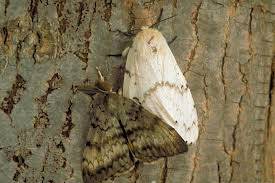ManageSafe™
Least-Toxic Control of Gypsy Moths Choose a different pests

|
Factsheet: Least-toxic Control of Gypsy Moths
Identification
Pest type: Insects
Gypsy moth caterpillars change appearance as they grow. Young caterpillars are black or brown and about ¼ inch (.6 cm) in length. As they grow, bumps develop along their backs along with coarse, black hairs. Each of the 11 sections of a developed caterpillar will have two coloured spots, the first five pairs, blue, and the last six, red. Mature caterpillars can be as long as 2 ½ inches (6.35 cm).
Is it a problem?
Tree damage is caused by the insect larvae, or caterpillars, which emerge from their eggs beginning in early spring and continuing through mid-May. Gypsy moth caterpillars prefer to eat oak, birch, apple, willow, linden, hawthorn, and sweet gum trees. Older caterpillars may also attack crabapple, cherry, beech, hickory, walnut, hemlock, and pine trees.
Pest prevention practices
In-Depth Information:
Trees maintained in a healthy and vigorous condition are less susceptible to infestation.
Monitoring and record-keeping
- Look for (and destroy) any egg masses in late summer, and again the following spring.
- An egg mass can be as large as a 50 cent piece, is usually oval and flat, and has a felt-like texture. They are found in sheltered locations, such as under tree limbs, tree trunks, tree wounds, corners around windows and doors, house eaves, gutters, fences, and woodpiles.
Non-chemical and mechanical controls
Handpick and destroy
In-Depth Information:
Sticky barrier bands keep caterpillars from climbing up the tree trunks. A barrier can be made with sticky gum products that are applied directly on the tree bark.
Sticky tape products are the best trap. for rough bark. Barriers are most effective when placed around the trunk by the first week in April. The barrier should be checked at least once a week, and removed when caterpillars are not seen for several days.
Make a burlap band. Place burlap hiding bands around tree trunks to reduce the number of wandering caterpillars and detect very low population levels. Instructions to make a burlap band can be found here.
Biological controls
- Natural predators, such as birds, spiders, beetles, flies, and wasps, help to control gypsy moth populations.
- If populations of gypsy moths get high enough that a biological insecticide is necessary, Bacillus thuringiensis is an option. This biological pesticide is a bacterium that attacks the gypsy moth caterpillar. It is very effective if applied properly and can be applied by commercial applicators. It should be used only after all caterpillars have hatched, but before they get to be about 1 inch in length, and good leaf coverage is essential. Two applications are necessary, five to seven days apart. As with any pesticide application, use extreme caution when applying Bt. It is non-specific and can harm species of butterflies and moths that are non-target and even beneficial or rare organisms. Use it only as a last resort when all other control tactics have failed.
- At high densities, the gypsy moth nuclear polyhedrosis virus (NPV) is the most frequent agent regulating populations. It is a naturally occuring virus that spreads among gypsy moths like the common cold. The product Gypchek contains the virus, but it is diffiuclt to obtain, and is relatively expensive.
Least-toxic chemical options as a last resort
Spray egg masses with dormant oils, vegtable based horticultural oils.
Chemicals to Avoid
Look at your product labels and try to avoid products containing those chemicals listed below:
(A = acute health effects, C = chronic health effects, SW = surface water contaminant, GW = ground water contaminant, W = wildlife poison, B = bee poison, LT = long-range transport)
|
Acephate Bifenthrin Carbaryl | Cyfluthrin Deltamethrin Diflubenzuron | Etofenprox Lambda-cyhalothrin Permethrin | Spinosad Tebufenozide |
Social Media
See what other folks are saying about this, and let us know what works for you.
Gypsy Moths: Welcome Back to Question of the Week!Question:I'm disabled with severe chemical sensitivity and my town...
Posted by Beyond Pesticides on Friday, February 12, 2016
Click the post above to view and comment on Facebook, or comment directly on this site below.








